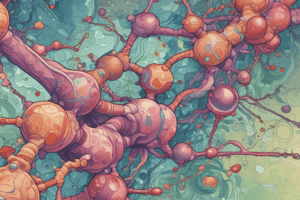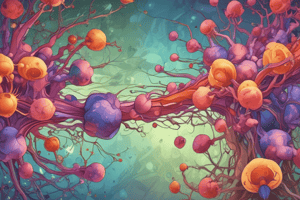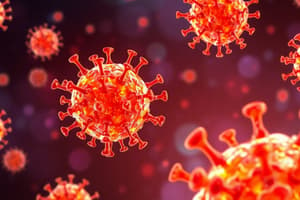Podcast
Questions and Answers
Which of the following is NOT a general property of cytokines?
Which of the following is NOT a general property of cytokines?
- They are cellular messengers.
- They exert effects via specific receptors on target cells.
- They are involved in cell differentiation.
- They always require a specific antigen to trigger their effects. (correct)
Initially, cytokines were believed to be produced only by lymphocytes. What name were they given because of this?
Initially, cytokines were believed to be produced only by lymphocytes. What name were they given because of this?
- Interleukins
- Lymphokines (correct)
- Monokines
- Chemokines
What is the general term used to describe the small secreted proteins that regulate immunity, inflammation, and hematopoiesis?
What is the general term used to describe the small secreted proteins that regulate immunity, inflammation, and hematopoiesis?
- Cytokines (correct)
- Chemokines
- Interleukins
- Monokines
What is the main function of cytokines within the immune system?
What is the main function of cytokines within the immune system?
How do cytokines exert their effects on target cells?
How do cytokines exert their effects on target cells?
What is the main reason why the immune system can effectively target specific threats while also maintaining overall control?
What is the main reason why the immune system can effectively target specific threats while also maintaining overall control?
Which of the following is NOT a common name used for cytokines based on their origin or function?
Which of the following is NOT a common name used for cytokines based on their origin or function?
What is the best way to learn about cytokines?
What is the best way to learn about cytokines?
Which of the following is NOT a characteristic of Interleukins?
Which of the following is NOT a characteristic of Interleukins?
What is the primary function of Interferons?
What is the primary function of Interferons?
How do Interferons warn neighboring cells about a viral infection?
How do Interferons warn neighboring cells about a viral infection?
Which of the following is a key function of Tumor Necrosis Factor (TNF)?
Which of the following is a key function of Tumor Necrosis Factor (TNF)?
What is the role of TNF in inflammation?
What is the role of TNF in inflammation?
How can dysregulation of TNF lead to disease?
How can dysregulation of TNF lead to disease?
Which of the following is considered a growth factor?
Which of the following is considered a growth factor?
Which of the following is NOT a colony stimulating factor?
Which of the following is NOT a colony stimulating factor?
Which of the following is NOT a known function of Tumor Necrosis Factor α (TNFα)?
Which of the following is NOT a known function of Tumor Necrosis Factor α (TNFα)?
Which of the following is a characteristic shared by both TNFα and TGF-β?
Which of the following is a characteristic shared by both TNFα and TGF-β?
What is the primary function of chemokines in the immune system?
What is the primary function of chemokines in the immune system?
What does the term 'pleiotropic' refer to in the context of cytokines?
What does the term 'pleiotropic' refer to in the context of cytokines?
What is the function of Transforming Growth Factor beta (TGF-β)?
What is the function of Transforming Growth Factor beta (TGF-β)?
Which of the following is NOT a characteristic of chemokines?
Which of the following is NOT a characteristic of chemokines?
The term 'redundant' in the context of cytokines refers to:
The term 'redundant' in the context of cytokines refers to:
What is the main implication of chemokines in inflammation?
What is the main implication of chemokines in inflammation?
Which of the following cytokines is involved in both inhibiting virus replication and activating macrophages?
Which of the following cytokines is involved in both inhibiting virus replication and activating macrophages?
Which cytokine family serves as a chemoattractant?
Which cytokine family serves as a chemoattractant?
What is the role of the alpha subunit in cytokine receptors?
What is the role of the alpha subunit in cytokine receptors?
Which of the following is NOT a proinflammatory cytokine?
Which of the following is NOT a proinflammatory cytokine?
Which cytokine is associated with the differentiation of B-cell progenitors in the marrow?
Which cytokine is associated with the differentiation of B-cell progenitors in the marrow?
Which two cytokines are involved in both T cell activation and B cell activation?
Which two cytokines are involved in both T cell activation and B cell activation?
What is the immediate consequence of cytokine binding to its receptor?
What is the immediate consequence of cytokine binding to its receptor?
Which cytokine family includes IL-2 and IL-4?
Which cytokine family includes IL-2 and IL-4?
Flashcards
Cytokines
Cytokines
Small secreted proteins that regulate immunity and inflammation.
Lymphokines
Lymphokines
Cytokines initially thought to be produced only by lymphocytes.
Monokines
Monokines
Cytokines secreted by monocytes and macrophages.
Interleukins
Interleukins
Signup and view all the flashcards
Chemokines
Chemokines
Signup and view all the flashcards
Cellular Messengers
Cellular Messengers
Signup and view all the flashcards
Diverse Functions
Diverse Functions
Signup and view all the flashcards
Receptor-Mediated Effects
Receptor-Mediated Effects
Signup and view all the flashcards
Tumor Necrosis Factor α (TNFα)
Tumor Necrosis Factor α (TNFα)
Signup and view all the flashcards
Apoptosis
Apoptosis
Signup and view all the flashcards
Neutrophil adherence
Neutrophil adherence
Signup and view all the flashcards
Transforming Growth Factor Beta (TGF-β)
Transforming Growth Factor Beta (TGF-β)
Signup and view all the flashcards
Chemotaxis
Chemotaxis
Signup and view all the flashcards
Pleiotropic effect
Pleiotropic effect
Signup and view all the flashcards
Synergistic action
Synergistic action
Signup and view all the flashcards
Proinflammatory Cytokines
Proinflammatory Cytokines
Signup and view all the flashcards
Antiinflammatory Cytokines
Antiinflammatory Cytokines
Signup and view all the flashcards
Cytokine Action Types
Cytokine Action Types
Signup and view all the flashcards
Hematopoietic Cytokines
Hematopoietic Cytokines
Signup and view all the flashcards
Interferon Family
Interferon Family
Signup and view all the flashcards
Cytokine Receptors
Cytokine Receptors
Signup and view all the flashcards
Signal Transduction
Signal Transduction
Signup and view all the flashcards
Cytokine Families
Cytokine Families
Signup and view all the flashcards
Function of Interleukins
Function of Interleukins
Signup and view all the flashcards
Interferons (IFN)
Interferons (IFN)
Signup and view all the flashcards
Role of Interferons
Role of Interferons
Signup and view all the flashcards
Tumor Necrosis Factor (TNF)
Tumor Necrosis Factor (TNF)
Signup and view all the flashcards
Function of TNF
Function of TNF
Signup and view all the flashcards
Growth Factors
Growth Factors
Signup and view all the flashcards
Study Notes
Cytokines
- Cytokines are small, secreted, low-molecular-weight proteins that mediate and regulate immunity, inflammation, and hematopoiesis.
- They are produced in response to an immune stimulus.
- Cytokine is a general term for a large group of molecules involved in cell signaling during immune responses.
- All cytokines are proteins; some have attached sugar molecules (glycoproteins).
- They are produced and released by white blood cells and tissue macrophages.
- Over 200 different human cytokines have been identified.
Types of Cytokines
- Originally called lymphokines (produced by lymphocytes)
- Then monokines (secreted by monocytes and macrophages).
- Then interleukins (produced by leukocytes and affect other leukocytes).
- Chemokines are also considered cytokines.
- The term "cytokine" is now a broad term encompassing all these types.
- Key categories of cytokines based on function include: Proinflammatory, Antiinflammatory, Inhibition of Virus Replication, Macrophage-Activating, B Cell-Activating, T Cell-Activating, Eosinophil/Mast Cell-Activating. Specific examples of cytokines within these categories are listed in the provided lecture notes.
Actions of Cytokines
- Autocrine: Affect the same cell that produced them (e.g., IL-2 promotes T-cell growth.)
- Paracrine: Affect nearby cells (e.g., IL-7 from marrow stromal cells promotes B-cell differentiation.)
- Endocrine: Affect distant cells through the bloodstream, (long distance effects.)
Cytokine Families
- Hematopoietic (IL-2, IL-4)
- Interferon (IFN-α, β, γ)
- Tumor necrosis factor family
- Chemokine family
Cytokine Receptors
- Proteins on cell surfaces (specific binding sites for cytokines).
- Crucial for transducing signals from cytokines into target cells
- Important for immune responses, inflammation, and cell growth
- Cytokine binds to alpha subunit, followed by association with the beta subunit. Signal transduction happens via the beta subunit.
- Majority of cytokine receptors are in Class I and Class II families.
Signal Transduction
- Begins with cytokine binding.
- Activates Janus kinase (JAK).
- Phosphorylation of tyrosine.
- Signal transducers and activators of transcription (STAT) binding follows.
- STAT translocation to the cell's DNA initiates transcription of specific target genes.
Main Sets of Cytokines
- Interleukins (IL-1 to IL-37)
- Interferons (IFN-α, β, γ)
- Tumor necrosis factors (TNF-α, TNF-β)
- Growth factors
- Colony stimulating factors
- Chemokines (specific examples like IL-8 are not explicitly listed here)
Interferons (IFNs)
- Signaling proteins produced by virus-infected cells (monocytes & lymphocytes).
- Secreted proteins that are key antiviral proteins.
- Interferes with viral replication (in infected and neighboring cells)
- Warn neighboring cells of viral presence.
Tumor Necrosis Factor (TNF)
- Crucial cytokine regulating immune responses and inflammation.
- Activates immune cells
- Promotes inflammation
- Regulates cell survival and proliferation
- Plays critical role combating infections and tissue damage
- Dysregulation can contribute to autoimmune diseases and cancer.
Transforming Growth Factor Beta (TGF-β)
- Multifunctional cytokine regulating cell proliferation, differentiation, adhesion, and migration.
- Belongs to the transforming growth factor superfamily (includes many other signaling proteins).
Chemokines
- Small proteins signaling molecules in the immune system
- Guide immune cells to specific locations.
- Chemotactic (induce cell migration).
- Recruit neutrophils, monocytes, and lymphocytes to sites of infection, inflammation, and tissue damage.
- Crucial role in mediating inflammation.
Functional Features of Cytokines
- Pleiotropy: one cytokine can have different effects on different cells.
- Redundancy: different cytokines can have the same effects.
- Synergy: cytokines can act together to enhance effects.
- Antagonism: cytokines can oppose each other's effects.
- Cascade effect: cytokines can stimulate the production of other cytokines.
- Influence on cytokine receptors: cytokines can influence the expression and transmodulation of receptors.
- Hematopoiesis: cytokines are crucial in regulating innate and acquired immunity.
Studying That Suits You
Use AI to generate personalized quizzes and flashcards to suit your learning preferences.




